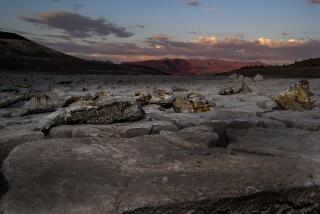Grim Disaster for U.S. Seen in Farm Drought
- Share via
CLAYTON, Ind. — In Howard Wreitzel’s 33 years of farming he has never seen a spring like this one. His corn is stunted by one of the earliest droughts on record, not even half as tall as it should be by mid-June. Some of his soybeans still have not sprouted. Those that have are scraggly, weed-like.
The ground on his west central Indiana farm is dry, “brick-hard.” When Wreitzel drives a tractor along the rows of weakened plants, the soil rises in dusty brown clouds that waft ominously across the fields, turning the otherwise clear day hazy beneath a frying sun.
Wreitzel and hundreds of thousands of other Midwest farmers are helpless this spring as one of the worst droughts of the century tightens across America’s Grain Belt. The National Weather Service predicts that the next 30 days will be abnormally warm--and abnormally dry. Drought also is gripping wide areas of the Southeast’s Cotton Belt and areas of the Northern Plains.
If the drought continues, it has the potential to become “a grim disaster” for the nation, Agriculture Secretary Richard E.. Lyng told farm state senators Tuesday in Washington.
For some regions, pastures and range lands have not been this dry since 1934--the first year of a three-year drought that earned its place in history as the Dust Bowl, and was described by John Steinbeck in “The Grapes of Wrath.”
“Most of the Cotton Belt is experiencing a drought that is growing worse and worse each day,” said Jess Barr, a National Cotton Council economist.
“The damage being inflicted on the corn crop now is irreversible,” warned Dale Gustafson, Chicago manager of commodity research for Drexel Burnham Lambert.
“If it continues throughout the summer there will be nothing to harvest,” said Tom Quirk, who grows barley in Climax, Minn.
“I don’t know how much longer we can hang on,” said Shirley Bowser who grows corn, soybeans and wheat in Williamsport, Ohio.
“We’re praying for rain and trying to keep from losing our children in the cracks in the earth,” said Art Smith, the Washington County agricultural agent in Greenville, Miss., where there has not been a countywide rain for more than eight weeks.
“When the temperatures are in the 90s and the wind blows at 30 m.p.h., the moisture just disappears,” complained Keith Larson, who grows wheat in Aberdeen, S.D. “Our crop is severely damaged. We’ll be fortunate if we get a fourth or a third of our normal harvest.”
‘No Levers’ to Pull
“There is no question that the situation is serious,” said Leo V. Mayer, a key Agriculture Department economist. “Weather is one factor which has such enormous influence (on agriculture) that there are no levers you can pull to fully offset it.”
There is no single place where data has been collected to measure the growing potential for disaster, but it can be seen in bits and pieces in reports from around the country. For example:
--Indiana, normally the nation’s third-largest producer of corn, reports that 66% of the state’s crop is in fair condition and 24% is poor. Only 8% of the crop is classified as good, down from 12% last week and 82% a year ago. Reports on the state’s soybean crop mirror those of the corn crop.
--In the last two weeks, the Agriculture Department has declared 845 counties in 18 states disaster areas so that farmers who have already exhausted their hay and pastures can graze livestock on land previously closed to grazing by the government.
--In portions of Montana, farmers will have no winter wheat crop to harvest because “it’s not harvestable,” said Lyle Pratt, the state statistician.
--In Buncombe County, N.C., “corn is normally . . . up to 15 inches tall by this time of year. The corn measures from nothing to six inches,” said Bobby Peek, the county agricultural agent. “There has not been enough moisture for (some corn) to germinate. The seeds are just lying there. This is the driest I remember for the past 25 years.”
Mississippi River Affected
--Record-low water levels on the Mississippi River are already slowing shipping on this major waterway used for moving much of the Midwest’s grain to ports for shipment overseas. There are fears that the river may have to be closed later in the summer.
--Farm ponds have dried up in northeastern Kansas, streams and rivers are low throughout the Midwest and throughout the Tennessee Valley. The Great Lakes, where 20% of the planet’s fresh water is stored, are rapidly falling back from their high water levels of two summers ago.
--In Kansas, more than 40% of the wheat crop is classified as poor to very poor, 38% of it is fair.
“When you see drought, you see hungry people,” said Indiana farmer Wreitzel. But that is not likely to be the bottom line, even if this turns out to be a national disaster.
Because of massive overproduction earlier in the 1980s, the United States has about a year’s supply of both corn and wheat to meet both domestic and export demands, Agriculture Department economist Leo V. Mayer said.
That surplus might come in handy. Only scattered thunderstorms are in the forecast for most of the region this week, not the steady, soaking rains that are needed to replenish and recharge the soil.
Researchers Ruth Lopez and Rhonda Bergman in Chicago, Lisa Romaine in Denver, Edith Stanley in Atlanta and Rhona Schwartz in Houston contributed to this story.
More to Read
Sign up for Essential California
The most important California stories and recommendations in your inbox every morning.
You may occasionally receive promotional content from the Los Angeles Times.










